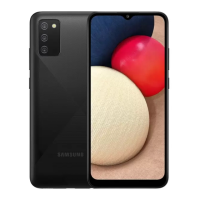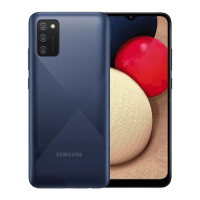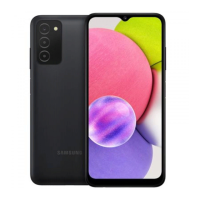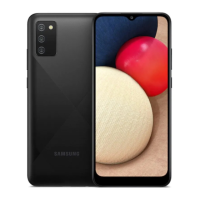Do you have a question about the Samsung SM-A025V and is the answer not in the manual?
General instructions, safety precautions, and device usage guidelines.
Information on device heating, causes, solutions, and safe operating environments.
Details on charging the battery, power saving, and battery status indicators.
Guides for installing SIM/USIM and memory cards, plus initial device setup.
Explains how to use the touchscreen, gestures, and navigate the device interface.
Instructions for downloading, installing, and managing applications from stores.
Core communication features including making calls, managing contacts, and sending messages.
Guidelines for accessing the web and setting up and using the email client.
Instructions for taking photos, recording videos, and managing media files.
Details on using advanced multitasking features for running multiple apps.
Managing network and wireless connectivity options like Wi-Fi, Bluetooth, and mobile hotspots.
Customizing audio settings, notification preferences, and screen appearance options.
Securing the device using screen lock methods, passwords, and biometric data.
Managing user accounts, backing up data, and using Samsung Cloud services.
Optimizing device performance and utilizing special features like motions and gestures.
Solutions for frequent device problems such as network errors or failure to turn on.
Addressing specific problems like Bluetooth not working, poor audio quality, or battery issues.
General instructions, safety precautions, and device usage guidelines.
Information on device heating, causes, solutions, and safe operating environments.
Details on charging the battery, power saving, and battery status indicators.
Guides for installing SIM/USIM and memory cards, plus initial device setup.
Explains how to use the touchscreen, gestures, and navigate the device interface.
Instructions for downloading, installing, and managing applications from stores.
Core communication features including making calls, managing contacts, and sending messages.
Guidelines for accessing the web and setting up and using the email client.
Instructions for taking photos, recording videos, and managing media files.
Details on using advanced multitasking features for running multiple apps.
Managing network and wireless connectivity options like Wi-Fi, Bluetooth, and mobile hotspots.
Customizing audio settings, notification preferences, and screen appearance options.
Securing the device using screen lock methods, passwords, and biometric data.
Managing user accounts, backing up data, and using Samsung Cloud services.
Optimizing device performance and utilizing special features like motions and gestures.
Solutions for frequent device problems such as network errors or failure to turn on.
Addressing specific problems like Bluetooth not working, poor audio quality, or battery issues.
| Model | SM-A025V |
|---|---|
| Network Technology | GSM / HSPA / LTE |
| Build | Glass front, plastic back, plastic frame |
| SIM | Single SIM (Nano-SIM) or Dual SIM (Nano-SIM, dual stand-by) |
| Resolution | 720 x 1600 pixels, 20:9 ratio (~270 ppi density) |
| Internal Storage | 32GB |
| Features | LED flash, panorama, HDR |
| Video | 1080p@30fps |
| Selfie camera | 5 MP, f/2.0 |
| Loudspeaker | Yes |
| 3.5mm jack | Yes |
| WLAN | Wi-Fi 802.11 b/g/n, Wi-Fi Direct, hotspot |
| Bluetooth | 5.0, A2DP, LE |
| GPS | Yes, with A-GPS, GLONASS, GALILEO, BDS |
| Radio | FM radio |
| USB | USB Type-C 2.0 |
| Sensors | Accelerometer, proximity |
| Battery Type | Li-Po 5000 mAh, non-removable |
| Status | Available |
| Display Type | PLS |
| Display Size | 6.5 inches |
| Operating System | Android 10 |
| CPU | Quad-core 1.5 GHz Cortex-A53 |
| RAM | 3GB |
| Main Camera | 13 MP |
| Macro Camera | 2 MP, f/2.4 |
| Charging | 15W wired |
| Colors | Black, Blue, Red |











